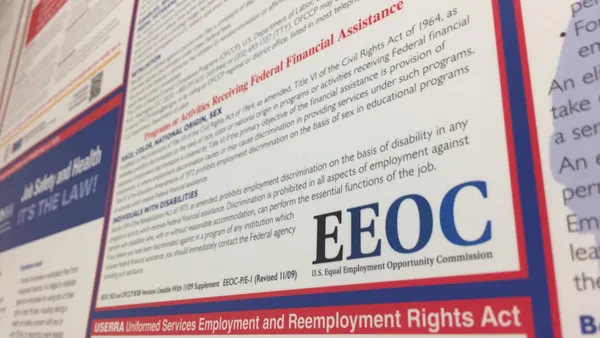Michael Hewitt and his employer, oil and gas company Helix Energy Solutions Group, agree: His duties as a tool pusher meet the description of a bona fide executive, administrative or professional employee under the Fair Labor Standards Act. They agree, too, that Hewitt is paid well for his services, earning more than $200,000 a year.
On the surface, those details alone may seem unlikely to give rise to an employment law dispute played out before the nation’s highest court. And yet, there Helix and Hewitt were on Oct. 12, with the nine justices of the U.S. Supreme Court analyzing a small wrinkle in an otherwise presumably straightforward employment relationship.
Namely, is Hewitt — a worker paid highly on a daily, rather than a weekly, basis — entitled to earn substantially more money in overtime pay?
A brief overview of FLSA’s salary requirements for OT exemption
Part 541 of the FLSA’s regulations describe the conditions under which bona fide executive, administrative or professional employees may be granted exemption from the law’s minimum wage and overtime requirements. To qualify, workers must not only perform certain duties as defined by the FLSA — i.e. the “duties test” — but they also must be compensated on a salary basis.
According to Part 541.600, exempt employees generally must be compensated on a salary basis at a rate of no less than the specified weekly amount, currently $684 per week. Part 541.602 further defines “salary basis” as a situation in which an employee receives a “predetermined amount constituting all or part of the employee’s compensation which amount is not subject to reduction because of variations in the quality or quantity of the work performed.” This amount must be received each pay period on a weekly or less frequent basis.
Of interest in Helix is Part 541.601, which outlines an exemption for certain highly compensated workers, defined as those with a total annual compensation of $107,432. These workers must still be paid at least $684 per week “on a salary or fee basis as set forth” in 541.602; the total annual compensation may include commissions, nondiscretionary bonuses and other nondiscretionary compensation; and employers are allowed to make so-called “catch up” payments to achieve the required pay level by the end of the year.
What makes Hewitt’s case of interest is that Helix compensated him using a day rate, arguably not on the “weekly or less frequent basis” specified in 541.602. Helix disputes this. In oral arguments Oct. 12, Paul D. Clement, counsel for Helix, said that Hewitt was guaranteed to earn $963 “for any week in which he worked a minute” and thus met the weekly minimum requirement, even though the company specified his rate as $963 per day.
Clement argued that this rate nonetheless satisfies 541.602’s salary requirement, because “the test is really, what is the amount that you receive in any week in which you work at least one minute? And for this worker, that was $963 or more, and that $963 was a guarantee.”
‘I don’t read the regulation that way’
Helix’s interpretation of the FLSA regulations met opposition from the court’s three liberal justices. Justice Ketanji Brown Jackson questioned Clement’s reading of 541.602, specifically that the regulation’s salary test could be summarized as the amount a worker receives in any week in which the worker works at least one minute.
“Counsel, I don’t read the regulation that way,” Jackson said. “In fact, when [541.602] talks about what it means to be paid on a salary basis, it appears to be looking at the predictability and the regularity of the payment, not the amount.”

Jackson asked how the definition of “salaried” employee could apply to Hewitt, given that his pay could differ from week to week: “One week, it could be the minimum amount because he worked a minute. Another week, it could be much more than that because he worked more than a minute. Why is that not the way we should think about salary basis given this regulation?”
Clement responded in part by saying that 541.602 “is quite specific” about the difference between salary and compensation. He said that the “predetermined amount” included in the salary basis definition of 541.602 need only constitute “all or part” of an employee’s compensation. “And, with all due respect, the regulation doesn't ask for stability above that,” he added.
A ‘sham’ salary?
That Hewitt is paid on a daily basis still may conflict with 541.602, according to Edwin Sullivan, counsel for the employee. That’s because 541.602 states, in part, that the exempt employee must receive the full salary for any week in which the employee performs any work “without regard to the number of days or hours worked.” For Helix to satisfy the salary requirement, Sullivan said its arrangement with Hewitt would need to adhere to Section 541.604(b), a different arm of the FLSA regulations.
541.604(b) specifies that an exempt employee’s earnings may be “computed on an hourly, a daily or a shift basis, without listing the exemption or violating the salary basis requirement,” provided that the employee’s work arrangement “also includes a a guarantee of at least the minimum weekly required amount paid on a salary basis regardless of the number of hours, days or shifts worked, and a reasonable relationship exists between the guaranteed amount and the amount actually earned.”
“I think it would be only a sham if they called it a salary, which it is not a salary.”

Edwin Sullivan
Counsel for Michael Hewitt
But Helix’s arrangement with Hewitt failed to satisfy 541.604(b)’s requirements, Sullivan said, a view that the 5th U.S. Circuit Court of Appeals articulated in a decision that would ultimately send Helix to SCOTUS.
Sullivan said Helix’s concession that it could not meet 541.604(b)’s requirements — and Helix’s argument that it should not have to meet 541.604(b) altogether — “is telling because [541.604(b) is] meant to avoid sham salaries.” That line drew inquiry from Justice Clarence Thomas, who asked Sullivan whether he thought Hewitt’s compensation was a sham.
“I think it would be only a sham if they called it a salary, which it is not a salary,” Sullivan said.
Further inquiry between Sullivan and Justice Brett Kavanaugh focused heavily on the $963 Helix would pay Hewitt on a biweekly basis if Hewitt worked one minute of one workweek. Since Helix guaranteed this $963 to Hewitt, why, Kavanaugh asked, would that not answer definitively the question of whether Hewitt received a salary?
With the help of some prompting from Jackson, Sullivan answered in part by stating that the $963 was a daily — not weekly — amount, and therefore did not satisfy 541.602’s requirement that the predetermined amount be received on a weekly or less frequent basis. Because Hewitt could earn more than $963 for working more than one day in one workweek, Sullivan argued that this also undermined Helix’s stance that the $963 was a “predetermined amount” for the purposes of 541.602.
“It has to be a predetermined amount on a weekly or less frequent basis,” he said. “That is not this. At best, if it's [$963], that is a predetermined daily amount.”
The case’s ‘core issue’
Helix involves a circuit split on whether the requirements of the highly compensated employee exemption laid out in 541.601 are in turn subject to the requirements of 541.604(b). The 5th Circuit answered in the affirmative, while the 1st and 2nd Circuits diverged, holding that 541.601 is not subject to 541.604(b)’s requirements.
Arguing for Helix, Clement said 541.601 is not subject to 541.604(b) because 541.601 “doesn’t address salary basis independently,” instead deferring to the definition of salary basis included in 541.602. “But [541.601] does address the issue of minimum guarantee plus extra,” Clement said, duplicating some of 541.604(b)’s provisions while contradicting others.
This speaks to the “core issue” presented in Helix, Paul DeCamp, member of law firm Epstein Becker Green, told HR Dive in an interview. “Helix’s argument here is that you don’t have to satisfy 541.604(b), because the day rate, under the general definition of 541.602, works as a salary just fine.”
Hewitt’s high payment amounts were a focus throughout the Oct. 12 oral arguments, particularly for the court’s conservative wing. Thomas noted that Hewitt’s annual income of some $200,000 would make it difficult to consider him as a “day laborer,” a point made even more salient in the FLSA’s regs; 541.601 states that a high level of compensation “is a strong indicator of an employee’s exempt status, thus eliminating the need for a detailed analysis of the employee's job duties.”
Potential outcomes in Helix
DeCamp said he expects a win for employer Helix in the case given the court’s composition, but that the final tally of justices is unclear at this time. Additionally, because the case deals with a narrow segment of the FLSA’s regulations involving a specific group of employees, “it probably won’t have a ton of effect on a lot of employers across the country,” DeCamp said.
Still, there is the potential that the justices — either as part of the majority or in a concurrence or dissent — could take a broader view of the administrative issues at play with respect to the FLSA’s regs and the law’s statute.
“What is noteworthy here is that the Supreme Court decided to hear the case at all,” Joshua Zuckerberg, partner at Pryor Cashman LLP, said in an email to HR Dive. “Considering the willingness that this Supreme Court has shown to imposing a critical lens on administrative action and regulations, and curbing the regulatory state in general, it is quite possible that this Court will take a dim view of the DOL’s salary basis test and may issue a ruling that the regulations are inconsistent with the FLSA, and/or are otherwise invalid.”
This possibility was most prominently raised in oral arguments by Kavanaugh.
“It seems a pretty easy argument to say, ‘oh, let's start with the fact that the regs are inconsistent with the statute and the regs are, therefore, just invalid across the board to the extent they refer to salary,’” he said. “I'm just saying, if it's not here, if the statutory argument is not here, I'm sure someone's going to raise it because it's strong.”
Should the justices decide to weigh in on this aspect of the case, “that’s where things could get interesting,” DeCamp said. He noted that the court has shown a willingness to tackle the subject of administrative rulemaking in recent cases such as West Virginia v. EPA, where it held that Congress did not grant the Environmental Protection Agency authority to devise certain emission caps.
“If I were betting, I’d expect that the analysis in the case will be pretty much exclusively focused on the regs and which reading of the regs is more correct,” DeCamp said. But, he said, a deeper dive into the FLSA could help to indicate — among other things — how the court may shift its approach toward interpreting and deferring to agency rulemaking.












